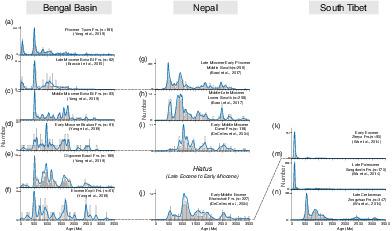当前位置:
X-MOL 学术
›
Geolog. J.
›
论文详情
Our official English website, www.x-mol.net, welcomes your feedback! (Note: you will need to create a separate account there.)
Geochemistry of Eocene to Pliocene strata of the Bengal Basin: Implications for provenance and erosion of the Himalaya
Geological Journal ( IF 1.8 ) Pub Date : 2020-10-29 , DOI: 10.1002/gj.4025 Lei Yang 1, 2 , Wenjiao Xiao 2, 3 , M. Julleh Jalalur Rahman 4 , Yunpeng Dong 1 , Songjian Ao 2 , Jiaopeng Sun 1 , Zhenyu Chen 2
Geological Journal ( IF 1.8 ) Pub Date : 2020-10-29 , DOI: 10.1002/gj.4025 Lei Yang 1, 2 , Wenjiao Xiao 2, 3 , M. Julleh Jalalur Rahman 4 , Yunpeng Dong 1 , Songjian Ao 2 , Jiaopeng Sun 1 , Zhenyu Chen 2
Affiliation

|
The earliest record of Himalayan detritus in the Himalayan foreland and the erosion sequence of different lithotectonic units of the Himalaya are critical for reconstructing collision and crustal deformation of the orogenic belt. In this study, bulk‐rock major, trace and rare earth elements of 19 fine‐grained clastic sedimentary rock samples from Eocene to Pliocene strata of the Bengal Basin were examined to study their provenance and erosion of the Himalaya. Combining with previous detrital zircon age data from the Bengal Basin, Nepal foreland basin, and South Tibet, we suggest that detritus from the uplifted Tethyan Himalayan Sequences and the Gangdese Arc had not been carried into the Himalayan foreland at least before Late Miocene, and that the Bengal Basin was in a passive continental margin setting from Eocene to Early Miocene, receiving detritus from a felsic sedimentary rock source. The earliest Himalayan detritus recorded in the Eocene strata of Bengal Basin were probably derived from the antecedent sedimentary cover of the Greater Himalayan crystalline rocks. We assume that the lack of Cretaceous Gangdese detritus in the Himalayan foreland from Eocene to Middle Miocene is due to a geomorphic barrier between the Tethyan Himalaya and the Himalayan foreland. Detritus from the Greater Himalayan crystalline rocks were first recorded in the Middle–Late Miocene Boka Bil Formation of the Bengal Basin, which is consistent with the uplift and exhumation time of the Greater Himalayan Sequences.
更新日期:2020-10-29


























 京公网安备 11010802027423号
京公网安备 11010802027423号